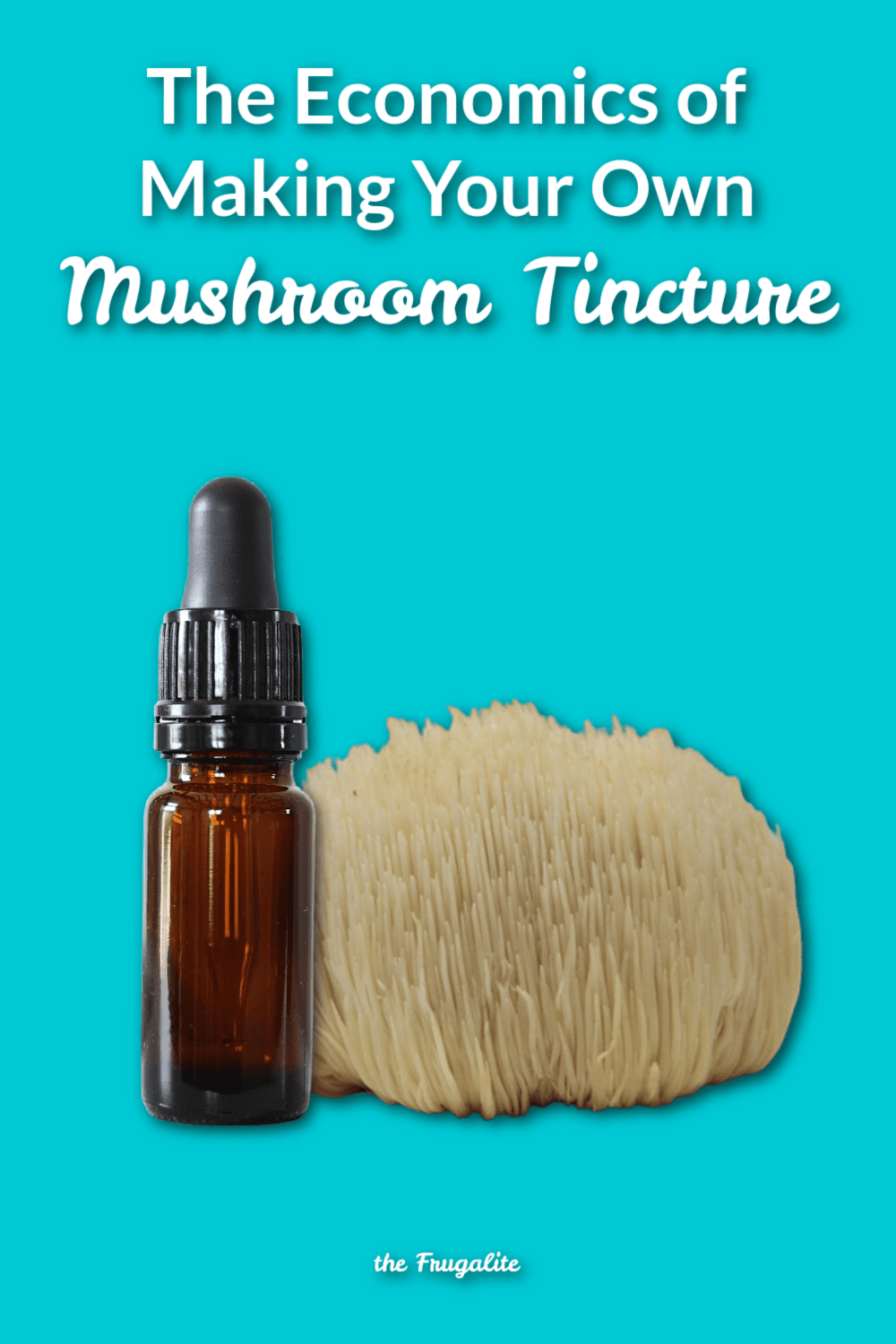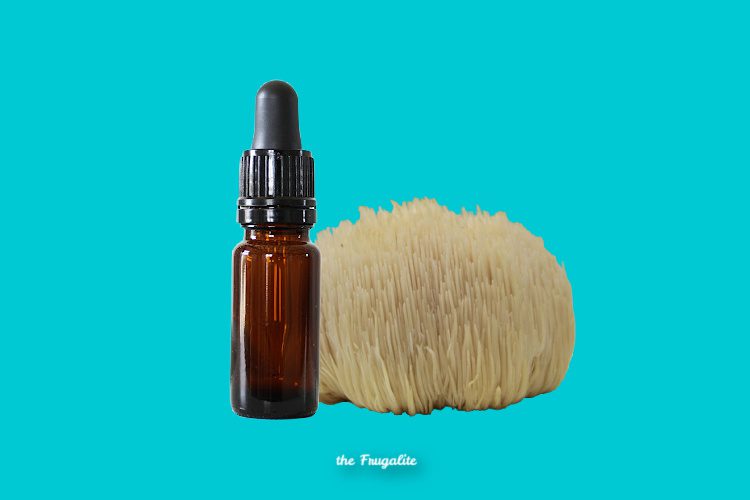(Psst: The FTC wants me to remind you that this website contains affiliate links. That means if you make a purchase from a link you click on, I might receive a small commission. This does not increase the price you’ll pay for that item nor does it decrease the awesomeness of the item. ~ Daisy)
I’ve written before about whether or not it’s cheaper to make things myself than it is to buy them. So far, that’s held true: not only is it cheaper, but the product is superior to store-bought. So, I thought I would apply this test to my mushroom tincture. I’ve put a few bucks into this project. Has it been cost-effective? Let’s see!
I’ve been working specifically with lion’s mane mushrooms for the tincture. My tincture has been made using the double extraction process detailed and linked in my first article. For those who don’t want to use alcohol, you’ll have to do some extra homework to find other methods. There are lion’s mane tinctures for sale that claim to be alcohol-free double extractions. From the research I’ve done, I’m a bit skeptical of the quality of these tinctures.
Chemistry is a thing. While many plant substances can be extracted via decoction or vinegar, mushrooms are a different animal. So caveat emptor! Your kitchen, your rules.
The rationale behind the alcohol-based method is that some qualities of the mushroom are better extracted by water, and others are better extracted by alcohol. By using each substrate, you get all of the good stuff. But is it cheaper than buying this product?
My costs for my mushroom tincture:
- $30 for a pre-made sawdust block kit
- $20 for Everclear
- $17 for the slow cooker
- $62 total
I used about 1/4 of the liquor per batch, plus I got to keep the slow cooker. The block gave two usable flushes, yielding 80 oz of tincture. Double alcohol extraction lion’s mane tincture on Amazon averages $35/2 oz bottle. That’s a pretty standard price.
I’ve made forty of those for a market value of $1360. I’d call that a pretty good return on my investment! Trendy costs, so, the kits are simple and very cost-effective.
I have a larger mushroom tincture project as well.
I’ve been trying to culture the fungus myself and create my own blocks rather than buying them. This project has included both shiitake and lion’s mane varieties.
Let’s add up the costs.
- Three pre-made tabletop kits: $85
- 20 lbs oak pellets: $29
- 10 lbs rye berry grain: $48
- 50 grow bags: $33
- Everclear: $20
- Slow cooker: $17
- Liquid cultures: $36
- Wheat bran: $8
- Mycology lids: $26
- PDA plates & books: $104
- Still air box: $95
- Straw: free
- Gallon storage bags: free
- Pressure canner: free
- Jars: free
Total expenses: $500
Total harvest: $1360 tincture + $60 shiitakes = $1420
Some explanation: the reason for buying the pre-made kits was to ensure that I got some mushrooms for my trouble and expense. I set myself up to win in the short term while working on a longer-term project. I was able to harvest live mycelia from those blocks, while the shiitake was produced in straw. The lion’s mane did not, and so I lost that culture and had to acquire more. My compost is going to be quite the interesting brew in spring!
The other way to grow your own mushrooms is to purchase liquid cultures (LC) in a variety of choices and inoculate grain spawn and/or PDA plates. I’ve found those to run about $6-$15, depending upon where you buy them from.
Tip: be sure to buy from reputable sellers! I bought one LC that turned out to be contaminated and lost a great deal of work, plus supplies. I also had to involve PayPal’s Resolution Center to get a refund! But I digress.
The basic process for making one’s own sawdust blocks goes like this:
- Grow the fungus in grain, making what’s termed spawn.
- Inoculate sterilized sawdust bags with spawn
- When the block has colonized, poke holes in the bag
- Harvest and use!
Sounds simple, doesn’t it? Ha!
I’ve had many contamination problems and had to toss my first homemade blocks, as well as a few jars of grain. This is why I bought the specialized lids and the still air box. Both can be made, lowering costs.
The oak pellets and rye grain are consumables but make quite a bit and were cheaper to buy in bulk. For example, the first 5 lbs of rye berry made almost 8-quart jars of spawn, and since only 4-5 cups of pellet are required per 5-lb block, 20 lbs are going to last me a while.
The wheat germ is a bit more pricey since each straw bag requires 1/4 cup (C) and each block requires 1 to 1-1/4 C, but it’s a necessary nutrient. Autoclavable grow bags cost me $0.55 each in bulk. These kinds are required to withstand the sterilization process in my pressure canner. The items listed as “free” were things I had already, such as my pressure canner. The freezer storage bags I use for veggies work quite well for mushrooms. Free is good. Frugalites love free!
So there are two paths that can be taken:
- Either buy the kits for the mushrooms, or
- Grow them ourselves from culture to sawdust block.
For those who prefer simplicity, the pre-made kits are cheap and very cost-effective. The larger experiment does take some time, effort, and investment. I have a science background that includes both mycology and microbiology. While this helped, I don’t think it’s totally necessary.
My two humble shiitakes were 3” across, and each went into one meal. The bigger picture says that success will be very economical as in the foreseeable future, I produce more mushrooms than I can use! In addition to the very nutritious food source, those might be bartered within my barter network for other, useful things. The only consumables I’ll have to replace are wheat germ, rye berry, bags, and liquor. The rest are one-time purchases. In my judgment, this larger project has a ton of potential and is therefore quite cost-effective as well.
I turn for inspiration to this quote by Fridtjof Nansen:
The difficult is what takes a little time; the impossible is what takes a little longer.
Do you make your own mushroom tinctures? Tell us about it in the comments below!
About Jayne
Jayne Rising is a gardener and bookworm with a BS from the University of Wisconsin and a Master Gardener certification. She’s been growing food on her small urban lot since 2010 and teaching others how to do it since 2015. She’s involved in a number of local urban agriculture initiatives, working to bring a sustainable and healthy food system back into the mainstream.












4 thoughts on “The Economics of Making Your Own Mushroom Tincture”
why? what is it for?
Mushrooms either dried or in tincture form last much, much longer than fresh. Therefore, if I can’t eat everything I’ve produced, I can put them away just the same as putting up other food. In addition to having many nutritional benefits, many mushrooms also have proven health benefits. Lion’s mane, for example, is very beneficial for brain health and in treating anxiety. Black pearl oysters, which I officially branched into today, have serious anti-inflammatory properties. I for one prefer this kind of medicine to Big Pharma, and at this point it’s cheaper food too. Any food I can produce myself can only help! That’s why, and what it’s for.
Interesting article.
Provided enough information to create an interest n promote further research.
I like it n will consider this a possibility for future use.
I love drying/dehydrating mushrooms for future use n often have made mushroom powder to add to smoothies n soups.
Daisy has me wanting to grow my own mushrooms n you expanded on that idea.
Thank you for this introduction.
Well done!!
You’re most welcome! Good luck! And keep checking back. There might be a mushroom cultivation course in this site’s future 😀